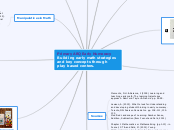Primary ABQ Early Numeracy Building early math strategies and key concepts through play based centers.
Subitizing
Students practice early numeracy by rolling playdough into the number symbols. They also make balls to squish into the 10 frames to represent each number.
Encourage the children to squish the balls as they count.
Subitizing is a fundamental numeracy concept. It is the ability of know the number of object based on their arrangement without having to count each one.
Students can practice subitizing number patterns from 1-10 using dice, 5-frames, 10-frames, or paper plates with bingo dot dabbers.
This early strategies helps students to see sets of numbers and allows them to have more efficient computation and mental math in later years.
Main topic
This center encourages early subtraction strategies.
The use of playdough provides sensory manipulative discovery and play in the development of numeracy concept of part whole relationship.
Main topic
This game can be played as a whole class. Each child chooses a bingo card. The teacher announces the number. The children can find any representation of that number and cover it on their card.
This game practices the concepts of subitizing
Lawson's Continuum
This continuum will help teachers to see early numeracy phases, strategies and key concepts. It is useful to know where learners are at and how to guide them to the next strategies on the continuum.
The continuum demonstrates early numeracy development in young children.
Sources
Clements, D. H. & Sarama, J. (2009). Learning and teaching early math: The learning trajectories approach. New York: Taylor & Francis. pp. 92-99.
Lawson, A. (2015). What to look for: Understanding and developing student thinking in early numeracy. Toronto, ON: Pearson Canada Inc. pp. 108-111; 132-133.
Modified Landscape of Learning: Number Sense, Addition, Subtraction (from Fosnot and Dolk, 2001).
Chapter 1 Mathematics or Mathematizing (pp 1-13) - in Fosnot, C.T & and Dolk, M. (2001). Young Mathematicians at work: Constructing number sense, addition and subtraction. Portsmouth: Heinemann.
The Kindergarten Program 2016 (Kindergarten Curriculum)
Strategies for early Addition and Subtraction
This center can be done in a large group setting.
Subtopic
This activity integrates music and kinesthetic multiple intelligence.
5 students can wear these tags. When the monkey falls off the bed the teacher writes the subtraction equation on the smart board.
Cardinality
This center are several bags that contain objects. Students can move the objects around in the bags to count them. Each bag is labelled with a letter. Students record the amount of objects in each bag on the sheet.
Early Cardinality is understanding that the final object tagged and counted represents all of the objects in the bag as a set.
Conservation
In this center Students are making and cooking cookies in the kitchen. They are using a flipper to turn over the cookies to determine which set of chocolate chips matches which number.
Number Representation. Symbol and the word are written for literacy integration. This activity is connects students with an authentic experience of cooking in the kitchen.
The early concept of conservation is that children understand the set of things are the same no matter their organization. In this instance the dots can be arranged in a variety of ways and students begin to understand it still represents 8 dots.
Manipulatives in Math
Having concrete objects such as manipulatives in this stage decreases the amount of information that needs to be held in the student’s head (Fosnot 2015).
This demonstrates why manipulatives are so crucial in developing big ideas in Math.
Students will later be able to count more efficiently and use tracking.
Coordinating
Subtopic
In this center students role the dice. They determine the number on the dice and put the same number of groovy buttons on the shirt.
Integration with Literacy helps children make connections to authentic problem solving. Pete the Cat is a well loved series and engages children in counting the buttons.
Early Counting involves coordinating the counting word with the tagging of each object. Saying one and pointing to one button.
Counting Sequence
This center engages children with goldfish crackers on a bowl placemat. They role the die and put the corresponding number of goldfish onto the bowl.
The early counting sequence is being able to name all the numbers in the correct order. 1,2,3 and so on.
Next step: Students can begin subtraction concepts by eating a goldfish from the bowl!
ONE to ONE counting
This center is marshmellows in a container. Students have to count out the same number of marshmellows as the number shown. Pompoms can be used or even smaller marshmellows.
This early numeracy skill of One-to-One counting shows students can point at/tag each object only once.
